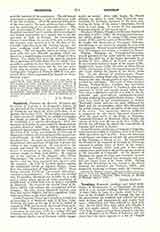

Vaudreuil, PHILIPPE DE RIGAUD, MARQUIS DE, Governor of Canada, b. in Languedoc, France, in the first half of the seventeenth century, of Louis R. de Vaudreuil and Marie de Chateau-Verdun; d. at Quebec, October 10, 1725. In the king’s musketeers, in which he served (1659-76), he ranked as brigadier and finally as colonel. He went to Canada (1687) in command of a marine detachment. After the massacre of Lachine he prevented the Iroquois from assailing Montreal (1689). In 1690 he shared in the defense of Quebec against Phips. In 1698 he received the Cross of St. Louis, and replaced, as Governor of Montreal, Callieres, who was promoted Governor-General of Canada. In 1702 the fief still bearing his name was given him. He again succeeded Callieres (1703), his prudence and experience fitting him to govern the colony at that trying period. He was loved by the people and feared by the Indians with whom he strove to strengthen an alliance, while the English colonies sought to shake their fidelity. He adopted one of the captives of the Abenaki raids, Esther Wheelwright, who entered the Ursuline cloister in Quebec, and was later appointed first superior after the conquest. In 1710 he fortified Quebec against the threatened attack of Admiral Walker, whose fleet was shipwrecked off Egg Island (1711). Peace being restored, Vaudreuil encouraged agriculture, commerce, and education. The country was divided into 82 parishes, Montreal was fortified by a wall, and a census taken, giving an entire population of 25,000 souls, of which 7000 were in Quebec and 3000 in Montreal. He received the Grand Cross of St. Louis (1721), and ordered the construction of Fort Niagara. His wife, Louise Elizabeth Joybert, who bore him twelve children, had been appointed (1708) undergoverness to the royal children.
LOUIS PHILIPPE, COUNT DE VAUDREUIL, second son of preceding, b. at Montreal, 1691; d. November 27, 1763. Entering the army at the age of seven he ranked as captain in 1738, and received the Grand Cross of St. Louis (1745). Transferred to the navy as chief of a squadron, he took part (1747) in a combat off Cape’ Finistere between the fleets of M. de l’Estenduere and Admiral Hawke, one of the most terrible engagements on record. After eight hours, the French admiral was about to yield, when Vaudreuil, commanding the Intrepide, hastened to the front, and, bearing the brunt of the enemy’s broadsides, forced them to cease firing. In reward he was appointed lieutenant-general of the naval forces.
FRANCOIS-PIERRE, MARQUIS DE RIGAUD, brother of preceding, b. February 3, 1703. He was appointed lieutenant (1724), Knight of St. Louis (1738), king’s lieu-tenant (1748), and Governor of Three-Rivers (1749). He fought with Montcalm at Chouaguen (Oswego), contributing to the victory by crossing the river with the vanguard. He was Governor of Montreal from 1755 until the conquest forced him to emigrate to France.
PIERRE, MARQUIS DE VAUDREUIL-CAVAGNAL, second governor of that name and the last under the French rule, fifth son of the former governor, b. at Quebec, November 22, 1698; d. in France about 1767. He successively ranked as major of the troops (1726), Knight of St. Louis (1730), Governor of Three-Rivers (1733), of Louisiana (1742), Governor-General of Canada (1755) during the period of the Seven Years War. To his demand of reinforcements, France responded by sending Montcalm, Levis, Bourlamaque, Bougainville, who, though unable to save New France, covered her with glory. The merit of their victories, Oswego, William-Henry, Carillon, has heretofore been too largely attributed to Vaudreuil, who never appeared in battle and merely issued orders that were often a hindrance instead of a help to the experienced and clear-sighted commander-in-chief, thereby rendering his exploits doubly heroic. Vaudreuil even tried in his correspondence to belittle Montcalm’s merit, and was too easily influenced by Bigot and his unscrupulous clique who dilapidated the public treasure to the detriment of the army and of the nation. This apparently rigorous judgment is supported by the latest historical researches. After the fatal battle of the Plains of Abraham, Vaudreuil withdrew to Montreal; when, despite the victory of Levis over Murray at St. Foy (1760), the French lost all hope, he signed the capitulation of Canada, and retired to France.
LOUIS PHILIPPE DE RIGAUD, COMTE DE VAUDREUIL, eldest son of preceding, b. at Quebec, 1723; d. in France, 1802; entered the navy in 1741. When the American revolutionary war began he refused the governorship of San Domingo to remain at sea. He commanded the Fendant at the conquest of Grenada by d’Estaing, captured 6 million livres of booty in his cruises, conquered Senegal (1779), took part in five other engagements, one of which, off the Chesapeake, resulted in the surrender of Cornwallis. At the disaster of Dominica he saved 12 ships and retreated successfully. Louis XVI thanked him personally and gave him the Grand Cross of St. Louis (1789). During the French Revolution he was elected to the States General; he defended the Tuileries (1792), and emigrated, returning to France under the Consulate.
LIONEL LINDSAY

